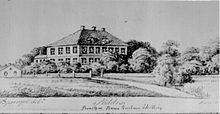Kalvi
Coordinates: 59 ° 29 ' N , 26 ° 47' E
Kalvi ( German Pöddes ) is a village in the Estonian rural community Aseri ( Ida-Viru district ). It has 40 inhabitants (as of 2003).
Kalvi Manor
The vassal castle in Kalvi was first mentioned in 1485. Its owner at the time, Hans Lode, pledged it for one hundred marks to the Tallinn bishop Simon von der Borch . In 1512 the land became the property of Dietrich Kalff , from whom the name of the place is derived.
Later the castle became largely useless and destroyed. In the second half of the 18th century, a massive early classical mansion was built from the remains of the east wing . From 1775, the later popular enlightener and German Baltic writer Friedrich Gustav Arvelius (1753-1806) was employed there as a private tutor. The entire ensemble of the manor comprised thirteen buildings in the 18th and 19th centuries. In 1910 the mansion burned down completely.
In 1913, the Baltic German Baron Nicolai von Stackelberg had a new property built just north of the old manor house. It is located on a steep slope, approx. 50 m above the Baltic Sea coast . The powerful facade of the three-story mansion was inspired by the Gothic . In addition, the Petersburg architect Wladislaw Karpowitsch also used elements of Art Nouveau and Baroque . The buildings were surrounded by a park of ten hectares, in the eastern part of which there was a pond with a small island. The mansion suffered badly from a major fire in 1921, but was renovated again. It had its own power station, sewer pipes and central heating .
In 1940 the property was expropriated by the Soviet occupation authorities. It then served as a rest home for miners.
The main building was extensively renovated at the beginning of 2000 by a Danish company and stylishly converted into a luxury hotel with a sauna and swimming area.
Web links
- Full description (Estonian)
- Luxury hotel Kalvi (Estonian and English)
- Kalvi Manor (German)


